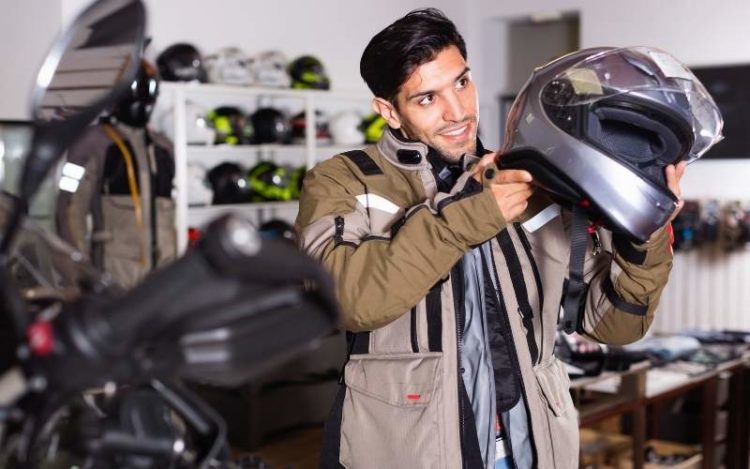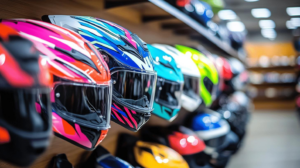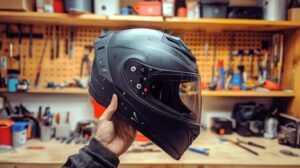It’s important to wear the right helmet before you hit the road. Wearing a helmet not only complements your unique style but also saves your life in case of an accident.
Many riders find it difficult to put on a helmet, claiming that it obstructs their vision or restricts their breathing.
Helmet manufacturers understand this and developed helmets with more advanced features, such as being lightweight, comfortable, allowing for good ventilation, and providing the most significant protection for your head in the event of a crash.
However, a helmet only does its job if it is worn in the correct size. If a helmet is too small, tight, or big on your head, it will not only make your ride uncomfortable, it’s also dangerous. Wearing the right size helmet will save your life.
But wait, are you having trouble deciding which helmet is best for you? No worries!
This guide will help you a lot in selecting the best motorcycle helmet for a safe and enjoyable ride. So, keep reading.
What you need to know before buying a new helmet?

Multiple features are important to consider before buying a new helmet and here we describe all of them.
Shape & Size
The helmet shape is the most essential factor to assure proper helmet fitment. Helmets are prepared in a variety of shell forms to accommodate various head shapes.
To determine the shape of your head, look yourself in the mirror and observe your head shape.
A helmet is designed for one of the three head shapes:
1. Round Oval, which is equally long front-to-back as its side-to-side measurements.
2. Intermediate oval, slightly longer front-to-back than its side-to-side measurements.
3. Long oval, head which is longer front-to-back than its side-to-side measurements.
Once you know your head shape, the next important thing is the size of your head.
To measure the right head size, you simply need to wrap a soft measuring tape around your head about half an inch above your eyebrows down to the back of your head.
If you don’t have a measuring tape, take a string, loop it around your head and mark the point where your head size is the largest. Now measure the string to get your right head size.
Compare your head size with the sizing charts of different brands because each helmet manufacturer provides a specific sizing chart for their helmets.
Remember, one size does not fit all. A motorcycle helmet that fits snugly and comfortably around your head is the best option for you.
Helmet type & Style
Another important factor to consider is the type of helmet you want. Helmets come in different styles to support the different types of riding.
- Half face helmet: aka as “Egg shapes helmet”. This type of helmet provides minimal protection by covering only the top of your head while leaving the rest of your face exposed. Some open face helmets, such as the Sena cavalry helmet, have ear inserts and a padded internal liner to provide a little additional coverage for your head and ears. The lighter weight of this helmet also gives more comfort by creating less neck fatigue than other heavier helmets.
- Open-face or 3/4 motorcycle helmet: This type of helmet completely protects the head part but not your face and chin area. They provide less protection but good ventilation and a better field of vision, suited for around-town rides. But the Scorpion EXO-CTT20 helmet is an exception. This open-face helmet offers jaw and cheek protection better than 99% of open-face helmets on the market, and it has two different visors. A full-face visor along with a drop-down sun visor to shield your eyes from harsh sun rays.
- Full-face helmet: Full-face helmets, such as the Biltwell Gringo, cover your entire head, face, and chin area, and no doubt they are the safest motorcycle helmets among all other types of helmets. But you have to compromise a little bit on airflow.
- Modular Helmets: aka “Flip-up” helmets are a popular style of helmet that combines the benefits of both open-face and full-face helmets. Modular helmets, like the Schuberth c4, provide the same level of comfort as open face helmets when worn with the chin-up position, and when closed, they provide the same weather protection as full-face helmets by keeping rain, snow, wind, and dust out of the rider’s face and eyes.
The type of helmet you need depends upon the type of riding you do most. Considering the bike, you want to ride also helps you a lot in choosing the right helmet type according to your safety and comfort.
How to find the right fit for a helmet?

Another important thing to carefully notice is that the helmet should fit tightly on your head when you first wear it. Not too tight, just the snug fit.
This is because, the cheek pads or inner liner of the helmets break in a little bit and give you the perfect fit after you have worn it for a while, whereas if you buy a loose helmet, it will move side to side during your ride. It is not only irritating but also very dangerous because the helmet won’t stay on your head if you hit the ground.
Wear your helmet for about 20-25 minutes before taking the final decision. You must feel even pressure on your head. If you feel some hotspots or pressure points on the sides, front, or back of your head, that’s probably because the helmet isn’t the best fit for your head shape or is too small.
A helmet must fit correctly so it can do its job.
An easy test to make sure you have a proper fit is to grab the chin bar with both hands and try to move your head left-right inside the helmet. You should have minimal lateral movement as it is necessary to reduce buffeting at higher speeds.
Safety ratings
The primary job of a helmet is to control energy in an impact to protect your head from a crash. Your helmets must be DOT approved, the most important certification issued by the US Department of Transportation, which makes your helmet legal to use on the road. Snell and ECE certifications can add trust to helmet safety standards. Therefore, a helmet like the Shoei rf 1200, which meets all DOT, ECE, and Snell safety regulations, has proven to be the safest low-profile motorcycle helmet.
Another innovative safety feature present in helmets like the Arai XD4 and Shoei 1400 is the E.Q.R.S. system. In case of an emergency, this E.Q.R.S. system allows medical personnel to remove the cheek pads of the helmet easily without causing damage to the rider’s neck and spine.
Helmet weight & comfort
Depending on the shell material and internal foaming, helmets usually weigh between 3 to 5 pounds.
A rightly fit helmet is the best approach to equally disperse the weight of a helmet around your head.
Besides, the material of the cheek pads and inner lining varies for helmets. Some helmet manufacturers use washable and removable inner lining and cheek pads, which improve comfort. If necessary, the cheek pads can be adjusted for a better fit.
A helmet that is too big for your head is likely to be noisier than one that fits perfectly. Since it does not seal the area around the neck roll, there would be a lot of road and wind noise. Investing in one of the quietest motorcycle helmets will also aid with hearing protection while riding.
Budget
There are a lot of helmet options available between $100-$200 which are good enough for everyday riding.
Premium helmets such as Shoei RF-SR cost between $250-$500 and have improved safety requirements and advanced features, but they are often only suitable for serious riding and are uncomfortable for daily use.
However, price is not everything. What matters most is the right size, shape, and type of helmet. If you wear a $500 helmet that does not fit properly, it would be useless.
Additional elements
Some additional features you can consider before purchasing a new helmet include Bluetooth, visor options such as a tinted visor or Pinlock visor to prevent fogging, or maybe no visor at all. In that situation, you’ll need goggles to protect your eyes from dust and wind pressure. Or you can also choose Shark Raw helmet if you don’t want to wear goggles separately, as this helmet comes equipped with an integrated face mask and goggles.
Conclusion
Helmet shape plays an important role in overall comfort and protection. It normally takes a month to get new helmet comfortable on your head. You’ll ensure your safety by wearing the right size helmet.
Before buying online, make sure that the helmet you are going to purchase is highly rated by the customers already used it.

Brad Mitchell is a seasoned motorcycle enthusiast with over 16 years of riding experience. He’s spent countless hours on the open road, particularly favoring scenic routes aboard his trusted Harley-Davidson. Brad’s laid-back approach to life and riding gives him a unique perspective on motorcycle gear and safety, which he shares through his in-depth reviews and expert advice on ProtectiveGearz.



